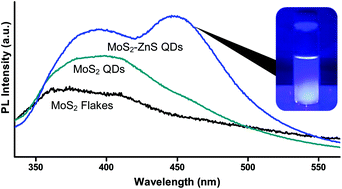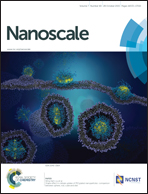Two-step synthesis of luminescent MoS2–ZnS hybrid quantum dots†
Abstract
A surfactant assisted technique has been used to promote the exfoliation of molybdenum disulphide (MoS2) in a water–ethanol mixture, to avoid the use of harsh organic solvents, whilst still producing sufficient concentration of MoS2 in suspension. The exfoliated flakes are converted into MoS2 quantum dots (QDs), through a hydrothermal procedure. Alternatively, when the flakes are processed with precursors for zinc sulphide (ZnS) synthesis, a simultaneous break-down and composite growth is achieved. The products are separated by centrifugation, into large ZnS spheres (200–300 nm) and small MoS2–ZnS hybrid QD materials (<100 nm), of which, the latter show favorable optical properties. Two concurrent photoluminescent (PL) peaks are seen at 380 and 450 nm, which are assigned to MoS2 and ZnS components of QDs, respectively. The PL emission from MoS2–ZnS QDs is of high energy and is more intense than the bare MoS2 flakes or QDs, with a quantum yield as high as 1.96%. The emission wavelength is independent from the excitation wavelength and does not change over time. Due to such properties, the developed hybrid QDs are potentially suitable for imaging and sensing applications.


 Please wait while we load your content...
Please wait while we load your content...